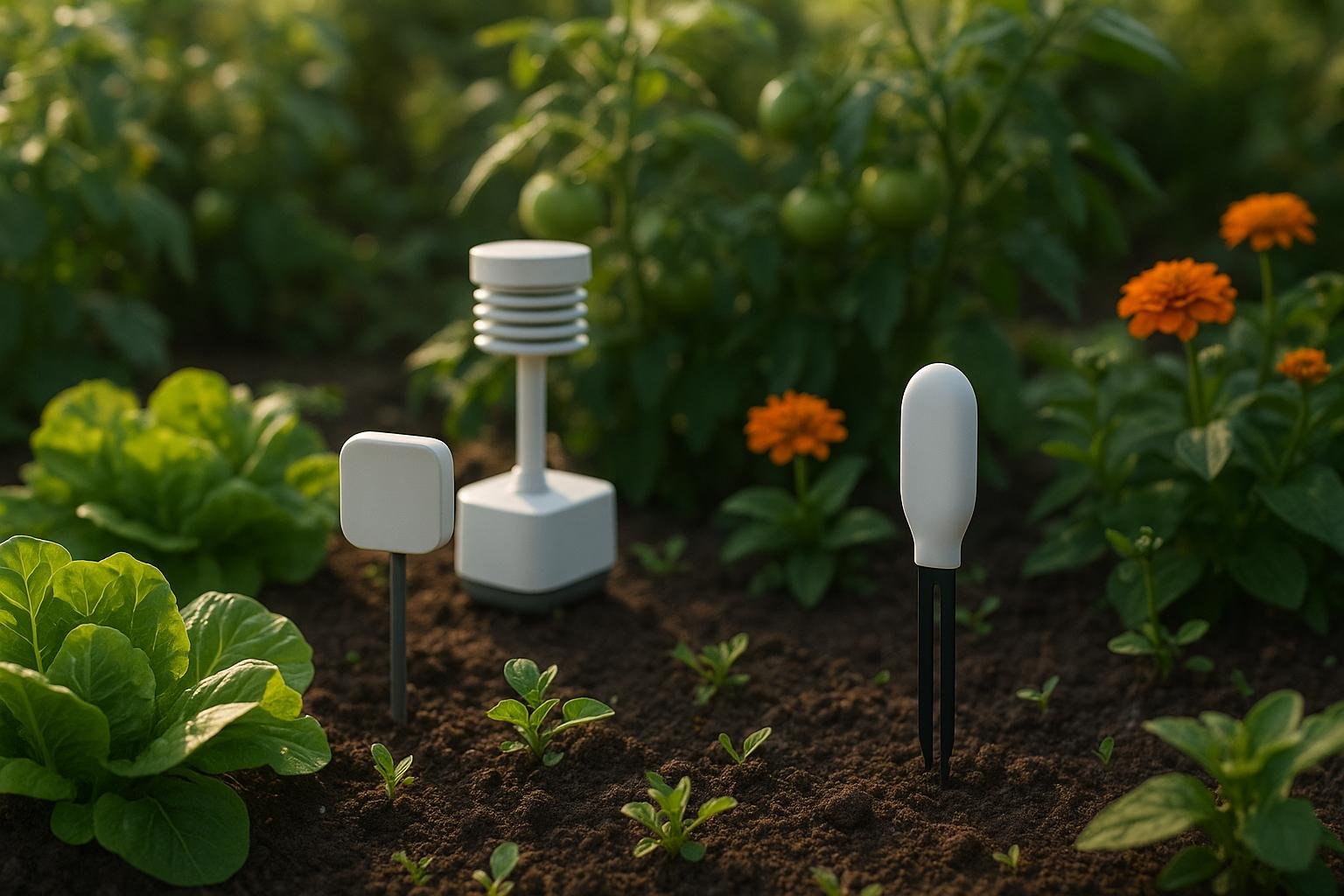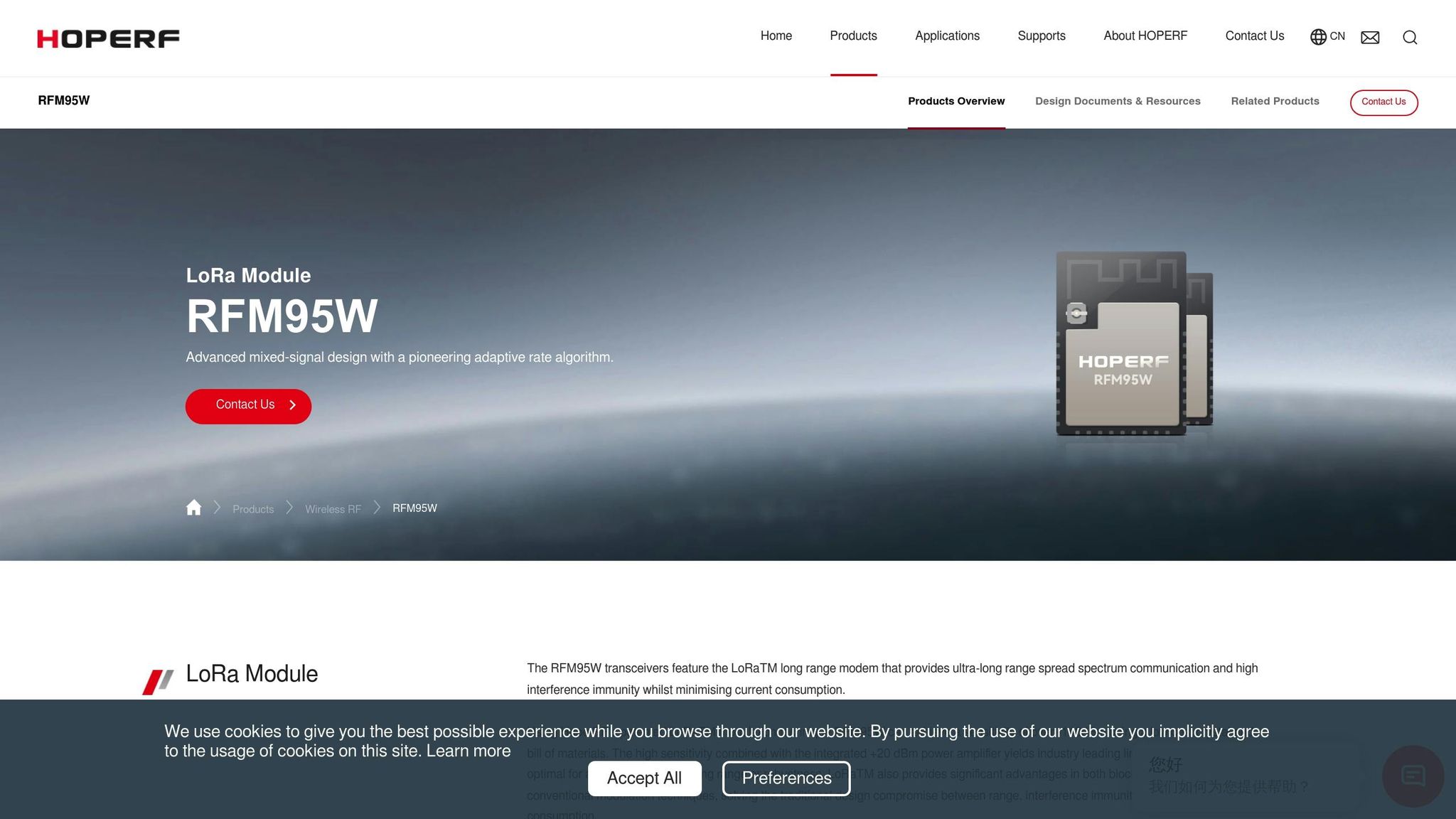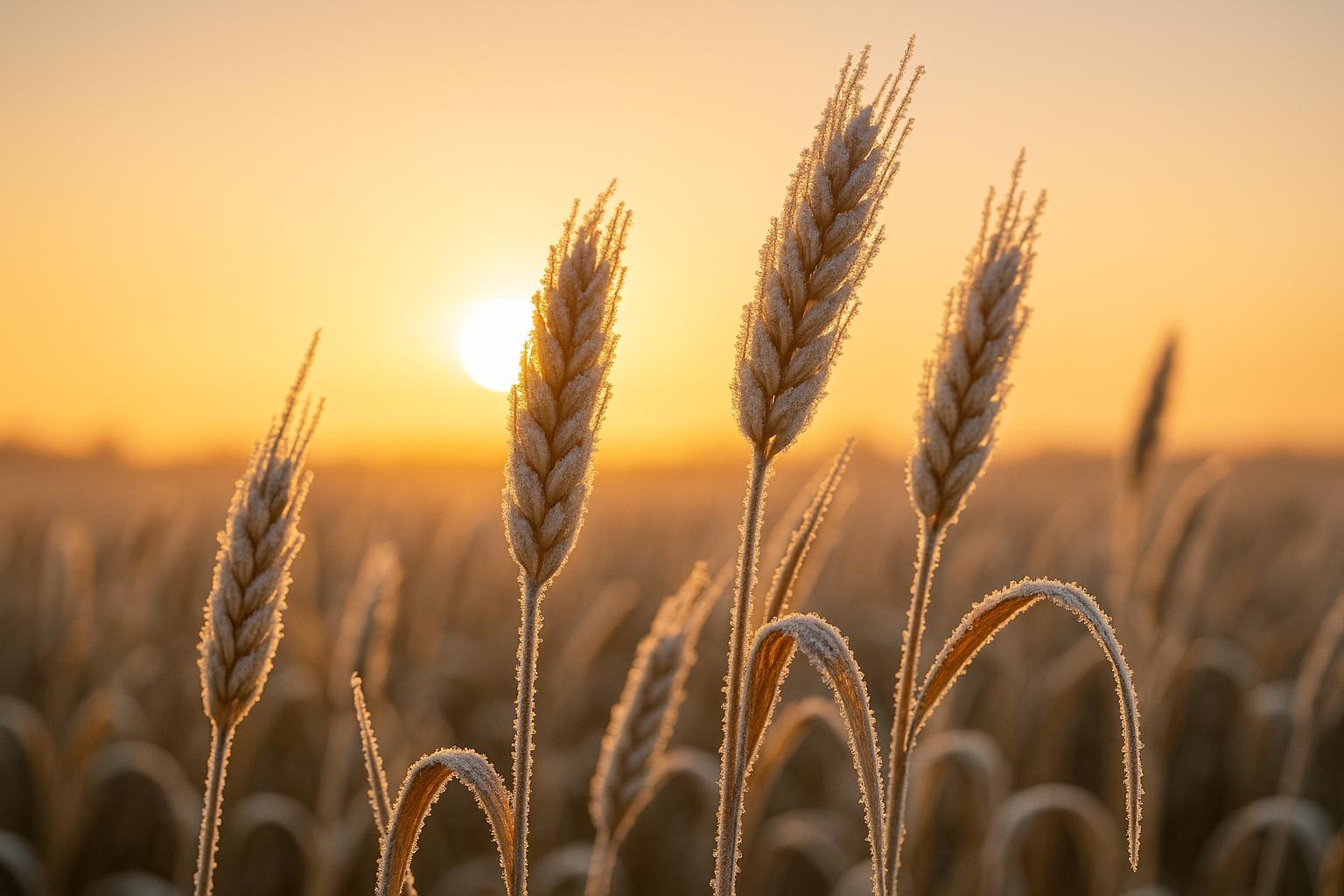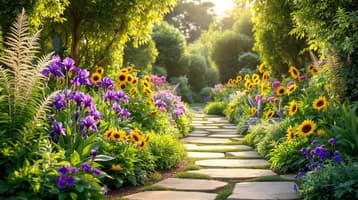IoT Protocols for Garden Sensors: Guide

IoT garden sensors are transforming plant care by offering real-time data on soil, temperature, and pests while automating tasks like watering and fertilizing. Choosing the right communication protocol is key to ensuring your system works efficiently. Here's a quick breakdown of what you need to know:
- Sensors: Devices like soil moisture sensors, thermal sensors, and RGB imaging detect plant health issues early.
- Protocols: Options include Wi-Fi, Bluetooth, Zigbee, LoRaWAN, and NB-IoT, each with trade-offs in range, power use, and data speed.
- Benefits: These systems reduce water and fertilizer use, automate pest monitoring, and improve plant health.
- AI Integration: Combining IoT with AI tools provides predictive insights, helping you act before problems grow.
Quick Protocol Comparison:
| Protocol | Range | Power Use | Data Speed | Ideal Use Case |
|---|---|---|---|---|
| Wi-Fi | 50–100 meters | High | Up to 600 Mbps | High-data tasks like video |
| Bluetooth/BLE | 50–150 meters | Low | 1 Mbps | Short-range, low-power needs |
| Zigbee | 10–100 meters | Low | 250 Kbps | Reliable mesh networks |
| LoRaWAN | Up to 15 km | Very Low | 0.3–50 Kbps | Large, remote gardens |
| NB-IoT | Wide area | Very Low | Varies | Professional setups |
The right protocol depends on your garden's size, layout, power availability, and data needs. For small home gardens, Wi-Fi or Bluetooth may suffice. Larger or remote areas benefit from LoRaWAN or NB-IoT. Pairing IoT with AI further enhances garden management by predicting risks and optimizing resource use.
IoT LoRa Based Smart Agriculture with Remote Monitoring System | RFM95 +Arduino+Soil Moisture Sensor


Key Sensors for Pest and Disease Monitoring
Modern garden sensors play a crucial role in tracking environmental conditions, soil quality, and plant growth trends, offering gardeners data-driven insights [1]. These sensors rely on IoT protocols to provide real-time updates, transforming pest and disease monitoring from guesswork into precise science.
Types of Sensors and Their Functions
Garden monitoring systems use a variety of sensors, each tailored to capture specific environmental factors that could indicate pest or disease issues. Knowing how these tools work can help gardeners select the most effective setup for their needs.
RGB Imaging Sensors utilize digital cameras to capture red, green, and blue light channels. By analyzing changes in color, texture, or shape, they can detect plant stress. For example, these sensors identify bacterial angular leaf spot in cotton [2].
Multispectral and Hyperspectral Reflectance Sensors measure how plants reflect light. Multispectral sensors work with broad wavebands, while hyperspectral sensors focus on narrower ones, offering detailed insights. These sensors are particularly effective at spotting stress before it becomes visible, such as detecting net blotch disease in barley caused by Pyrenophora teres [2].
Thermal Sensors monitor plant temperature to gauge water stress and identify early signs of infection. Changes in temperature patterns often signal problems before physical symptoms appear. For instance, thermal sensors detect Cercospora leaf spot in sugar beet [2].
Fluorescence Imaging Sensors track chlorophyll fluorescence, which reflects photosynthetic activity. When pests or diseases disrupt this process, fluorescence patterns shift, making it possible to detect issues like leaf rust in wheat caused by Puccinia triticina [2].
Soil Moisture and Conductivity Sensors keep tabs on soil conditions, which directly impact plant health and pest behavior. These sensors can cut water use by 20–30% by ensuring irrigation happens only when necessary. They also help reduce fertilizer use by 15–25% by providing real-time data on soil nutrient levels [3].
| Sensor Type | Target Crop | Disease/Pathogen Detected |
|---|---|---|
| RGB | Cotton | Bacterial angular (Xanthomonas campestris) |
| Spectral sensors | Barley | Net blotch (Pyrenophora teres) |
| Thermal sensors | Sugar beet | Cercospora leaf spot (C. beticola) |
| Fluorescence imaging | Wheat | Leaf rust (Puccinia triticina) |
These sensors can be integrated into handheld devices, tractors, drones, satellites, and more, depending on the garden’s size, budget, and monitoring needs [2].
Importance of Real-Time Data
Real-time data collection allows for quick responses, significantly reducing crop losses. With diseases responsible for about 16% of global annual yield losses, this technology is invaluable [4]. Unlike traditional visual inspections, which can vary in accuracy, sensor-based methods provide consistent and reliable results [2].
A great example of this in action is the TEKTELIC KIWI Agriculture Sensor used in a Calgary community garden. This system continuously monitored soil moisture, temperature, and conductivity, automatically activating irrigation when moisture levels dropped too low. This approach not only ensured proper hydration but also reduced water use by 30% compared to the previous season [3].
IoT-enabled devices are particularly effective at spotting early signs of pest infestations and diseases by continuously analyzing field data. This minimizes the need for manual inspections and optimizes resources. Moreover, lightweight AI models integrated with affordable edge devices make precision agriculture more accessible, even for small-scale gardeners.
"Insects are a symptom that there's something wrong with the growing conditions in your garden. If you use pesticides, you're treating the symptom. If you try and make those growing conditions better, you're correcting the cause."
- Eliot Coleman, Organic gardener and author [5]
Real-time monitoring also enables automated decision-making. Sensors, actuators, and processors work together to gather crucial data - such as soil conditions, crop health, and weather patterns - ensuring timely interventions. This not only maximizes the impact of actions but also avoids wasting resources, providing a smarter way to manage gardens and crops.
IoT Communication Protocols Overview
Now that you've chosen the right sensors for your garden monitoring setup, it's time to figure out how these devices will communicate. This is where IoT communication protocols come into play. Think of them as the "language" your sensors use to share data - whether it's soil moisture, temperature, or early warnings about plant diseases.
The protocol you choose has a big impact on how your system performs. Some are great for transferring large amounts of data quickly, while others are better suited for conserving battery life or covering long distances. Understanding these differences is key to matching the right protocol with your garden's needs. Let’s dive into some of the most common options and see how they stack up.
Common Protocols for Garden Sensors
Wi-Fi is one of the most widely used protocols in garden monitoring. Operating on 2.4 GHz and 5 GHz bands, it supports data rates of up to 600 Mbps [6][7]. With a range of about 50 to 100 meters (164–328 feet), Wi-Fi works well for most residential gardens. Since it's already integrated into many home networks, it’s easy to set up. However, its high power consumption means you’ll need frequent battery replacements or a steady power source [6].
Bluetooth and Bluetooth Low Energy (BLE) are great for short-range, battery-powered devices. These protocols, typically operating around 2.5 GHz, offer a data rate of about 1 Mbps and a range of 50 to 150 meters (164–492 feet). Their low energy use is perfect for devices that don’t need constant monitoring, allowing batteries to last much longer.
Zigbee strikes a balance between power efficiency and reliable networking. Operating on the 2.4 GHz band, Zigbee supports data rates of around 250 Kbps and ranges from 10 to 100 meters (33–328 feet). Its standout feature is mesh networking, where devices can relay messages. If one sensor goes offline, others can step in to keep the data flowing - making it ideal for continuous monitoring setups.
LoRaWAN (Long Range Wide Area Network) is perfect for large or remote gardens. It can transmit data over distances of up to 15 kilometers (about 9.3 miles) at rates between 0.3 and 50 Kbps. Its ultra-low power consumption makes it a great option for areas without easy access to electricity.
NB-IoT (Narrowband Internet of Things) uses existing cellular networks to provide wide-area coverage with minimal power usage. It’s a reliable choice for applications requiring consistent connectivity over long distances. However, it may come with recurring cellular service fees. This protocol is particularly suited for professional setups that need dependable, real-time monitoring.
Protocol Comparison
The best protocol for your garden depends on your specific needs. Here’s a quick look at how they compare in terms of range, power usage, data speed, and ability to handle real-time monitoring:
| Protocol | Range | Power Consumption | Data Rate | Real-Time Monitoring |
|---|---|---|---|---|
| Wi-Fi | 50–100 meters (164–328 feet) | High | Up to 600 Mbps | Yes |
| Bluetooth/BLE | 50–150 meters (164–492 feet) | Low | 1 Mbps | No |
| Zigbee | 10–100 meters (33–328 feet) | Low | 250 Kbps | Yes |
| LoRaWAN | Up to 15 km (≈9.3 miles) | Very Low | 0.3–50 Kbps | No |
| NB-IoT | Wide area | Very Low | Varies | Yes |
Wi-Fi is ideal for high-bandwidth tasks like streaming video from pest-monitoring cameras or pulling in detailed environmental data from multiple sensors. For occasional data collection, such as checking soil moisture during a visit, Bluetooth and BLE are energy-efficient options. Zigbee’s mesh network makes it reliable for larger, interconnected setups, while LoRaWAN is the go-to for monitoring vast or remote areas. If you’re running a professional operation, NB-IoT offers reliable, low-power connectivity over long distances.
With this comparison in mind, you’re ready to choose the protocol that best fits your garden’s unique requirements.
sbb-itb-4d6a8dd
🚀 Ready to Reinvent Your Garden?
Join thousands of homeowners who have transformed their gardens using our AI design tool. Upload one photo to explore endless possibilities.
Get your AI garden designs →Choosing and Setting Up the Right Protocol
Selecting the right IoT protocol for your garden depends on several factors, including its size, layout, and the specific power and data requirements. What works for a small herb garden might not be suitable for a sprawling vegetable patch or a distant greenhouse.
Factors to Consider When Choosing a Protocol
-
Garden Size and Layout
Think about the physical scope of your garden. For compact spaces, protocols like Wi‑Fi or Bluetooth often suffice. However, for larger or more spread-out gardens, options like LoRaWAN or Zigbee mesh networks provide better coverage. -
Power Availability
Evaluate the proximity of power sources. If sensors can be placed near outlets, power-hungry options like Wi‑Fi are viable. For battery-powered or remote areas, energy-efficient protocols such as BLE or LoRaWAN are more appropriate. -
Data Transmission Needs
Consider how much data you need to transmit. Basic readings like soil moisture require minimal bandwidth and can work with low-data protocols. On the other hand, applications like live video feeds demand higher bandwidth, making Wi‑Fi a better choice. -
Budget Considerations
Factor in both initial and ongoing costs. While cellular-based solutions may involve monthly fees, protocols like LoRaWAN typically avoid recurring charges, making them more economical for long-term use. -
Existing Infrastructure Compatibility
Assess how the protocol fits with your current setup. If you already have a strong Wi‑Fi network, expanding it might be the easiest route. Similarly, if you’re integrating with smart home systems, protocols like Wi‑Fi or Zigbee are often more seamless. -
Environmental Factors
Take into account potential interference from your surroundings. Dense foliage or metal structures can disrupt certain signals. Protocols like LoRaWAN and NB‑IoT are often better suited for challenging environments compared to Wi‑Fi or Bluetooth.
Once you’ve considered these factors, you can move forward with implementing your chosen protocol.
Implementation Steps
After evaluating your needs, follow these steps to set up your system effectively:
Start with a site survey to pinpoint the best sensor locations. Use tools like smartphone apps or range tests to check for coverage gaps before committing to permanent installations.
Begin with a pilot installation by deploying a small number of sensors. This trial phase helps you test the reliability of data transmission, battery performance, and signal strength over time. It’s much easier to address issues early on than after a full-scale deployment.
Configure your network infrastructure to support your chosen protocol. For Wi‑Fi, ensure your router can handle the additional devices - older routers may struggle with multiple connections. For Zigbee, position the central hub strategically to optimize the mesh network. If using LoRaWAN, you might need a dedicated gateway unless you’re tapping into an existing commercial network.
Install sensors methodically, starting close to the hub and expanding outward. This step-by-step approach makes it easier to identify and address range limitations. For battery-operated sensors, think about accessibility for routine maintenance throughout the year.
Set up your data monitoring system before full deployment. Define alert thresholds for critical readings like soil moisture or temperature, and configure automated actions such as irrigation or notifications when those thresholds are breached.
Test the system under different conditions. Weather events like rain, snow, or dense foliage can impact signal strength, so it’s wise to evaluate communication reliability across various scenarios.
"Ensure gateways support the communication protocol used by your sensors" [8].
For battery-powered sensors, implement effective power management. Use low-power modes and schedule regular battery checks. Many sensors can send low-battery alerts, helping you avoid unexpected downtime.
"Regularly check sensor battery levels and update firmware" [8].
Combining IoT with AI Garden Tools
Bringing IoT sensors together with AI transforms raw environmental data into practical insights, enabling smarter, more efficient garden management. This pairing paves the way for advanced, data-driven solutions in garden care.
Using IoT Data for AI-Driven Insights
AI platforms work by analyzing the constant flow of data from IoT sensors, uncovering patterns that would be tough to spot manually. Sensors tracking temperature, humidity, soil moisture, and air quality feed into algorithms that can predict issues like pest infestations, disease outbreaks, or less-than-ideal growing conditions.
For example, platforms like AIGardenPlanner use this data to create tailored recommendations for plant care and irrigation. If soil moisture sensors detect a drop in water levels, the AI can check weather forecasts, plant requirements, and historical trends to suggest the exact amount and timing for watering.
The integration deepens when GPS data from sensors combines with environmental readings to map out your garden’s microclimates. This allows AI systems to make location-specific recommendations - like suggesting different fertilization for a shaded area versus a sunny spot.
A great example of this is Fermata’s Croptimus platform, which merges AI-enhanced cameras with sensor data for continuous crop monitoring. This system can detect pests or diseases earlier than human observation, reducing the need for pesticides. As Valeria Kogan, Fermata’s Founder and CEO, puts it:
"We make sure that they don't get out of hand and there are no significant outbreaks." [10]
These practical applications show how AI can anticipate and address garden challenges before they escalate.
Benefits of IoT and AI Integration
Pairing IoT sensors with AI tools brings clear advantages in managing gardens more efficiently while improving plant health. Pests and diseases account for up to 30% of crop losses [10], but integrated systems help reduce these losses through early detection and timely interventions.
Resource use also becomes more precise. AI processes real-time data, ensuring targeted applications of water, fertilizer, or treatments instead of blanket approaches. This precision cuts down on waste, lowers costs, and reduces environmental strain.
With IoT sensors monitoring your garden around the clock, you’ll receive automated alerts for critical conditions like sudden temperature changes, low soil moisture, or poor air quality - even if you’re away. AI analysis adds another layer by identifying trends and predicting potential problems days or weeks in advance. For instance, a combination of soil and humidity data might signal a higher risk of fungal disease, allowing you to act before it spreads.
By replacing guesswork with data-driven decisions, AI-powered systems optimize resource use across different garden zones. When your system suggests adjusting watering schedules or applying treatments, these recommendations are based on actual conditions and proven patterns.
Projects like the PACMAN SCRI initiative showcase even more advanced possibilities. Their system uses computer vision, AI, and machine learning to manage crop loads with precision, helping to measure fruitlets, predict fruit set, and forecast harvests with remarkable accuracy.
For home gardeners, this integration offers professional-level care made simple. Maintenance schedules adjust in real time, making it easier for gardeners of all skill levels to achieve thriving, healthy gardens.
Conclusion
Choosing the right IoT protocol for your garden sensors is a key step in tackling crop losses, which can range from 20% to 40% globally - amounting to as much as 40 million tons of grains lost annually in China alone [11]. The ideal protocol depends on factors like your garden's size, layout, and energy requirements. Different wireless technologies bring unique benefits, making it essential to align your choice with your specific setup [11]. This highlights the importance of reliable data transmission to support timely and informed decisions.
Real-time monitoring has revolutionized garden management, allowing continuous tracking of factors critical to plant health. IoT-enabled sensors and automated traps equipped with cameras can now detect pest activity more efficiently than traditional methods, which often rely on manual inspections and widespread chemical use [9]. This shift makes pest control smarter and more precise.
When IoT protocols are paired with AI tools, the benefits multiply. Platforms such as AIGardenPlanner can analyze sensor data alongside plant care recommendations and growing guides. This integration not only improves the accuracy of AI-driven insights but also optimizes water, fertilizer, and pest treatment applications, reducing costs and minimizing environmental impact [13].
The potential for data-driven garden management is immense. The global smart agriculture market is projected to triple by 2025, reaching $15.3 billion, while the smart farming market is expected to grow to $28.56 billion by 2030 [12]. These numbers reflect the increasing value of adopting innovative, real-time monitoring technologies for more sustainable gardening practices.
Real-world examples already showcase these possibilities. In China, IoT-based pest prevention and control systems have been successfully applied to crops like cucumber, tomato, and rice, significantly reducing pesticide use [11]. For home gardeners, this technology now offers professional-grade care, with maintenance schedules that adapt in real time to the unique conditions of each garden.
FAQs
What should I consider when selecting an IoT protocol for my garden sensors?
When picking an IoT protocol for your garden sensors, it's important to weigh factors like power efficiency, data transfer speed, and range. For instance, if your sensors run on batteries, a low-power protocol is a smart choice. On the other hand, if your garden spans a larger area, you'll want a protocol with a longer range.
You should also think about network scalability, especially if you plan to add more sensors down the line. Don't overlook security features either - keeping your data safe is crucial. And remember, the environment matters too. Outdoor conditions or interference from nearby devices can affect how well your system performs.
Choosing the right protocol means your garden monitoring system will run smoothly, securely, and give you reliable, real-time updates.
How does combining AI with IoT sensors improve garden care and plant health?
Integrating AI with IoT sensors is transforming garden care, offering real-time insights into essential factors like soil moisture, temperature, and plant health. With this data at their fingertips, gardeners can make informed decisions - whether it's fine-tuning watering schedules, spotting pests early, or catching diseases before they become a bigger issue.
By automating these tasks, AI not only minimizes water waste but also promotes healthier plant growth and a thriving garden. These smart systems eliminate the uncertainty of traditional gardening, giving you more time to relax and enjoy your outdoor space.
What are the pros and cons of using LoRaWAN and NB-IoT for monitoring large or remote gardens?
LoRaWAN works well for large or remote gardens thanks to its ability to cover long distances, energy efficiency, and affordability. That said, it does have some drawbacks, such as slower data transmission speeds and limited network capacity, which could be an issue for applications requiring heavy data transfer.
On the flip side, NB-IoT stands out with its broad coverage, low power requirements, and strong indoor signal strength, making it a dependable option for areas with tough connectivity conditions. However, it falls short in supporting mobility and may experience network congestion in extremely large deployments. The best choice depends on your garden's size, the type of sensors you plan to use, and any connectivity obstacles you might face.
🎨 Visualize Your Dream Garden Today!
Transform any outdoor space into a professional landscape design in minutes. Just upload a photo, choose your style, and let our AI do the rest.
Start your garden transformation now →Related posts
Related Articles

Checklist for Zen Garden Structure Maintenance
Explore essential maintenance tasks to preserve the serene beauty of your Zen garden, ensuring its tranquility and vibrant health.

AI Research on Frost-Resistant Crops
Explore how AI is revolutionizing the development of frost-resistant crops, benefiting both farmers and home gardeners with tailored solutions.

How Persian Gardens Adapt to Seasonal Changes
Explore how Persian gardens ingeniously adapt to seasonal changes through smart design, plant selection, and water features for year-round beauty.

How AI Matches Colors and Textures in Gardens
Explore how AI simplifies garden design by matching colors and textures, creating personalized layouts for thriving outdoor spaces.

Exploring the Impact of AI on Landscape Design
Discover the role of artificial intelligence in transforming landscape design processes, from automated design generation to plant selection and maintenance.

Symbolism in Chinese and Japanese Gardens
Explore the profound symbolism in Chinese and Japanese gardens, revealing how each element fosters meditation and harmony with nature.